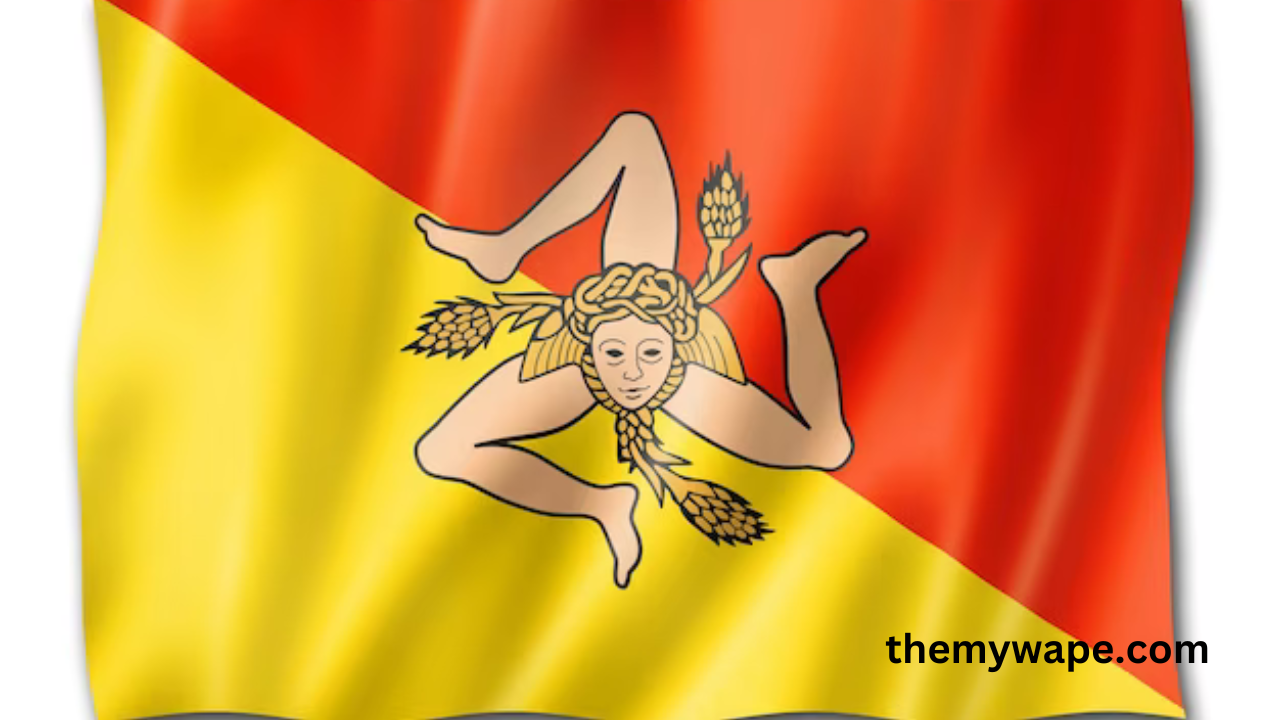Introduction to the Sicily Flag
The Sicily flag is more than just a symbol of a region; it embodies the rich history, diverse culture, and unique identity of the Sicilian people. With its distinctive design, the flag has become an emblem of pride and resilience for those who call this Mediterranean island home. But what does this flag represent, and how did it come to be? Let’s dive into the story behind the Sicily flag.
History of the Sicily Flag
Origins in Ancient History
The history of the Sicily flag is deeply rooted in ancient times. Sicily’s prime location in the Mediterranean has made it a crossroads for various civilizations over the centuries, including the Greeks, Romans, Arabs, and Normans. Each of these cultures left a mark on the island, contributing to the rich tapestry of its history and, ultimately, its flag.
Influence of Various Cultures on the Flag’s Design
The Sicily flag we know today is the culmination of centuries of cultural exchange and conquest. The flag’s most recognizable feature, the trinacria, is believed to have originated from the ancient Greek symbol used to represent the island of Sicily, which the Greeks called “Trinacria” due to its triangular shape. This symbol evolved over time as different cultures added their own interpretations.
Official Adoption of the Flag
The flag in its current form was officially adopted on January 28, 2000. However, the Trinacria symbol has been associated with Sicily for much longer, appearing on coins and artifacts dating back to antiquity. The official adoption of the flag marked a significant moment in Sicilian history, solidifying the Trinacria as a key symbol of the region’s identity.
Detailed Description of the Sicily Flag
Design Elements and Colors
The flag of Sicily features a bold design with diagonal sections of red and yellow, extending from the top left corner to the bottom right. In the center lies the Trinacria symbol, which features a Gorgon’s head is surrounded by three bent legs. Each element of the flag has a specific meaning, reflecting the island’s heritage and the values of its people.
The Trinacria Symbol
The trinacria is undoubtedly the most distinctive feature of the Sicily flag. The symbol consists of a gorgon’s head with three legs radiating from it, forming a triangular shape. The Gorgon, typically represented by Medusa, symbolizes protection, while the three legs represent the three corners of the island. This unique emblem is steeped in mythology and has been a part of Sicilian iconography for centuries.
The Colors and Their Meanings
Emotional Expression: “The colors of the Sicilian flag hold symbolic meaning.”
4o
. Red represents the bravery and strength of the Sicilian people, while yellow signifies the fertile lands and the wealth of natural resources found on the island. Together, these colors reflect the resilience and prosperity of Sicily, qualities that have defined the region throughout its history.
The Trinacria: A Unique Symbol
Origins of the Trinacria symbol
The Trinacria symbol has its origins in ancient Greece, where it was used to represent the island of The term “Trinacria” originates from the Greek word for “triangle,” highlighting the island’s distinctive triangular shape. Over time, this symbol became synonymous with Sicily, representing its unique geographical and cultural identity.
Representation of Medusa and the Three Legs
The Gorgon’s head at the center of the Trinacria is often linked to Medusa, a character from Greek mythology famous for her snake-like hair and her power to petrify those who gaze upon her. turn people to stone with her gaze. The three legs, bent at the knee and positioned in a radial pattern, represent the three caps of Sicily: Capo Peloro, Capo Passero, and Capo Lilibeo. Together, these elements create a powerful symbol of protection, strength, and unity.
Connection to Ancient Mythology
The Trinacria symbol is deeply connected to ancient mythology. The combination of Medusa’s head and the three legs is thought to represent the island’s defense against invaders and the resilience of its people. This connection to mythology adds a layer of depth to the Sicily flag, making it not just a regional emblem but a symbol with roots in ancient beliefs and traditions.
The Evolution of the Sicily Flag
Influence of Different Rulers and Cultures
Sicily has experienced a rich and varied history, with control passing through numerous powers such as the Greeks, Romans, Byzantines, Arabs, Normans, and Spanish. Each of these groups introduced their distinct symbols and colors, which have significantly shaped the design of the Sicilian flag. The current flag is a testament to this rich history, combining elements from different eras into a cohesive and meaningful design.
Modern-Day Flag Design
The modern Sicily flag, with its bold colors and distinctive Trinacria symbol, is a reflection of the island’s enduring identity. Officially adopted in 2000, the flag has become a symbol of pride for Sicilians, both on the island and in the diaspora. The design is simple yet powerful, capturing the essence of Sicily in a way that resonates with its people.
Cultural and Regional Significance
What the Flag Means to the People of Sicily
The flag holds deep meaning for the people of Sicily, representing their distinct identity and rich cultural heritage. It represents the island’s history, culture, and resilience of its people. The flag is often displayed during regional celebrations and events, where it serves as a reminder of the island’s proud past and its hopeful future.
Use of the Flag in Regional Celebrations and Events
The flag of Sicily is often displayed at local festivals, regional celebrations, and public gatherings. It is often displayed alongside the Italian flag, symbolizing the island’s autonomy within the larger context of Italy. Whether it’s during the Feast of Saint Agatha in Catania or the Palio dei Normanni in Piazza Armerina, the flag is a central part of the festivities, uniting Sicilians in a shared sense of pride.
The Flag as a Symbol of Sicilian Identity
Beyond its use in official settings, the Sicily flag is a symbol of Sicilian identity. It can be seen flying from homes, businesses, and public buildings across the island. For many Sicilians, the flag is a representation of their unique culture, one that has been shaped by centuries of history and a strong sense of community.
Comparisons to Other Regional Flags
Similarities with Other Regional Italian Flags
The Sicily flag shares certain similarities with other regional Italian flags, particularly in its use of bold colors and historical symbols. Like the flag of Sardinia, another island region, the Sicily flag reflects the island’s unique identity while also acknowledging its place within the broader Italian nation. Both flags use colors and symbols that are deeply rooted in their respective histories.
Differences that Set the Sicily Flag Apart
While there are similarities, the Sicily flag also stands out for its unique design. The Trinacria symbol, with its combination of mythology and geography, sets it apart from other regional flags. Additionally, the diagonal division of the flag’s colors is a distinctive feature that is not commonly seen in other Italian regional flags, making it instantly recognizable.
The Influence of Neighboring Regions on the Design
The design of the Sicilian flag reflects the influence of nearby regions, especially those with which Sicily has shared historical connections.This connection to neighboring regions highlights the interconnectedness of Mediterranean cultures.
The Sicily Flag in Modern Times
How the Flag is Used Today
Today, the Sicily flag is used in a variety of contexts, from official government buildings to personal residences. It is a common sight during public demonstrations and cultural events, where it serves as a symbol of Sicilian pride.
Representation in Government and Official Buildings
In government buildings across Sicily, the flag is prominently displayed alongside the Italian national flag and the European Union flag. This arrangement symbolizes Sicily’s role as an integral part of both Italy and the European community. autonomous region within Italy, with its own distinct culture and identity. The flag is also used in official documents and ceremonies, where it symbolizes the authority and heritage of the Sicilian government.
The Flag in Contemporary Sicilian Culture
In modern Sicilian culture, the flag has evolved into a powerful emblem of regional pride and identity. It is often featured in art, literature, and media, where it represents the island’s unique cultural heritage. The flag has also become a widely embraced theme in both fashion and design, found in various forms across apparel and home décor.
Modern Interpretations and Redesigns
In recent years, there have been some calls to redesign the Sicily flag to better reflect contemporary values and sensibilities. These proposals often suggest modifications to the Trinacria symbol or the addition of new elements that represent the island’s modern identity. However, such changes have been met with resistance from those who see the current design as a vital link to Sicily’s past.
Public Opinion on the Current Design
Despite the debates, public opinion largely favors the current design of the Sicily flag. For many Sicilians, the flag is a cherished symbol of their history and culture, and any attempt to alter it is seen as an affront to their identity. This strong attachment to the flag’s design underscores its importance as a symbol of regional pride.
The Sicily Flag and Tourism
The Flag as a Symbol for Tourists
For tourists visiting Sicily, the flag is a familiar symbol that represents the island’s rich history and culture. It is often seen on postcards, souvenirs, and other merchandise, making it a key part of the island’s tourism industry. The flag’s distinctive design and vibrant colors make it a popular choice for tourists looking to take home a piece of Sicily.
How the Flag is Marketed in Sicily’s Tourism Industry
The Sicily flag is heavily marketed in the tourism industry, where it is used to promote the island’s unique cultural heritage. It appears on everything from t-shirts to keychains, making it a ubiquitous symbol for visitors. The flag’s association with Sicily’s rich history and vibrant culture makes it a powerful tool for attracting tourists.
Popular souvenirs and merchandise featuring the Sicily Flag
Among the most popular souvenirs featuring the Sicily flag are clothing items, such as t-shirts and scarves, as well as decorative items like magnets, flags, and posters. These items often feature the Trinacria symbol and the flag’s bold red and yellow colors, making them instantly recognizable. For many tourists, these souvenirs are a way to connect with the island’s unique culture.
The Sicily Flag in Media and Pop Culture
Representation in films, TV, and literature
The Sicily flag has made numerous appearances in films, TV shows, and literature, often serving as a symbol of the island’s distinct identity. In many cases, the flag is used to convey a sense of place or to highlight the cultural backdrop of a story. Its distinctive design makes it an easily recognizable symbol that instantly evokes the spirit of Sicily.
The Flag as a Symbol of Resistance or Pride
In addition to its role in media, the Sicily flag has also been used as a symbol of resistance and pride in various social and political movements. Whether it’s in the context of regional autonomy, cultural preservation, or anti-mafia activism, the flag has become a rallying symbol for those advocating for the rights and identity of the Sicilian people.
Famous Personalities and Their Connection to the Sicily Flag
Many famous personalities, particularly those of Sicilian descent, have embraced the Sicily flag as a symbol of their heritage. From actors and musicians to politicians and activists, these individuals often display the flag as a sign of pride in their Sicilian roots. Their connection to the flag helps to keep its symbolism alive in the public consciousness.
The Sicily Flag and Its Role in Education
Teaching the History of the Flag in Schools
The history and symbolism of the Sicily flag are taught in schools across the island, where it serves as an important part of the curriculum on regional history and culture. Through lessons on the flag, students learn about the island’s past, its cultural heritage, and the significance of the Trinacria symbol. This education helps to instill a sense of pride in their Sicilian identity.
Educational Programs and Initiatives
Various educational programs and initiatives have been launched to promote awareness of the Sicily flag and its significance. These programs often include lectures, exhibitions, and workshops that explore the history and meaning of the flag. By engaging students and the public in these activities, educators hope to preserve the flag’s legacy for future generations.
The Flag in Academic Research and Publications
The Sicily flag has also been the subject of academic research and publications, where it is analyzed from historical, cultural, and sociopolitical perspectives. Scholars have explored the origins of the Trinacria symbol, the evolution of the flag’s design, and its role . in shaping Sicilian identity. These studies contribute to a deeper understanding of the flag’s significance.
The Sicily Flag as a Symbol of Unity and Division
How the Flag Unites Sicilians
The flag of Sicily serves as a strong emblem of unity for the Sicilian people.. It represents their shared history, culture, and identity, bringing together Sicilians from all walks of life. Whether it’s during a public celebration, a political rally, or a cultural event, the flag serves as a reminder of the common bonds that tie Sicilians together.
The Flag in Political and Social Movements
The Sicily flag has also played a role in various political and social movements on the island. It has been used as a symbol of regional autonomy, cultural preservation, and social justice. In these contexts, the flag is often seen as a rallying point for those advocating for the rights and interests of the Sicilian people.
Controversies Around the Flag’s Use in Protests
While the flag is a symbol of unity, its use in protests and political movements has also sparked controversy. Some view the flag as a symbol of resistance and defiance, while others see it as a divisive tool that can inflame tensions. These differing perspectives highlight the complex role that the flag plays in Sicilian society.
Global Recognition of the Sicily Flag
International Perception of the Sicily Flag
The Sicily flag is recognized not only within Italy but also around the world. For many, it is a symbol of the island’s rich cultural heritage and its unique place in the Mediterranean. The flag is often seen at international events, where it represents the Sicilian community and its contributions to global culture.
The Flag’s Presence in Global Events
The Sicily flag has made appearances at various global events, including cultural festivals, sporting events, and international conferences. At these gatherings, the flag serves as a representation of Sicilian identity and pride. Its presence on the world stage helps to raise awareness of the island’s history and culture.
The Sicily Flag as a Symbol of Heritage Abroad
For Sicilian communities living abroad, the flag is a cherished symbol of their heritage. It is often displayed at cultural events, parades, and family gatherings, where it serves as a reminder of their connection to the island. The flag helps to keep Sicilian traditions and values alive in the diaspora, ensuring that they are passed down to future generations.
Conclusion
The Sicily flag is more than just a regional emblem; it is a symbol of the island’s rich history, cultural heritage, and enduring identity. From its ancient beginnings to its contemporary importance, the flag has been a key element in defining the identity of the Sicilian people. Whether it’s flying proudly at a public event or displayed in a private home, the flag serves as a powerful reminder of the island’s unique place in the world.
FAQs
The Trinacria symbol on the Sicilian flag represents a rich blend of historical and cultural significance.” It portrays a figure with three curved legs extending from a central point, representing the three capes of Sicily and emphasizing the island’s triangular form. This ancient emblem also embodies the fusion of various influences, including Greek mythology, where the three legs are associated with the sun’s movement. The face in the center is often said to be the head of Medusa, representing protection and the island’s resilience against adversaries. The Trinacria symbol, featuring a Gorgon’s head and three legs, represents Sicily. It signifies protection and symbolizes the island’s three caps.
When was the Sicily flag officially adopted? The Sicily flag was officially adopted on January 28, 2000.
What colors are used in the Sicily flag, and what do they mean?” The flag of Sicily features red and yellow hues, representing the courage and resilience of the Sicilian people, as well as the island’s rich soil and abundant natural resources.
How is the Sicily flag used in modern times? The Sicily flag is used in a variety of contexts, including official government buildings, regional celebrations, cultural events, and by Sicilian communities abroad.
You can see the latest updates on : My Wape



